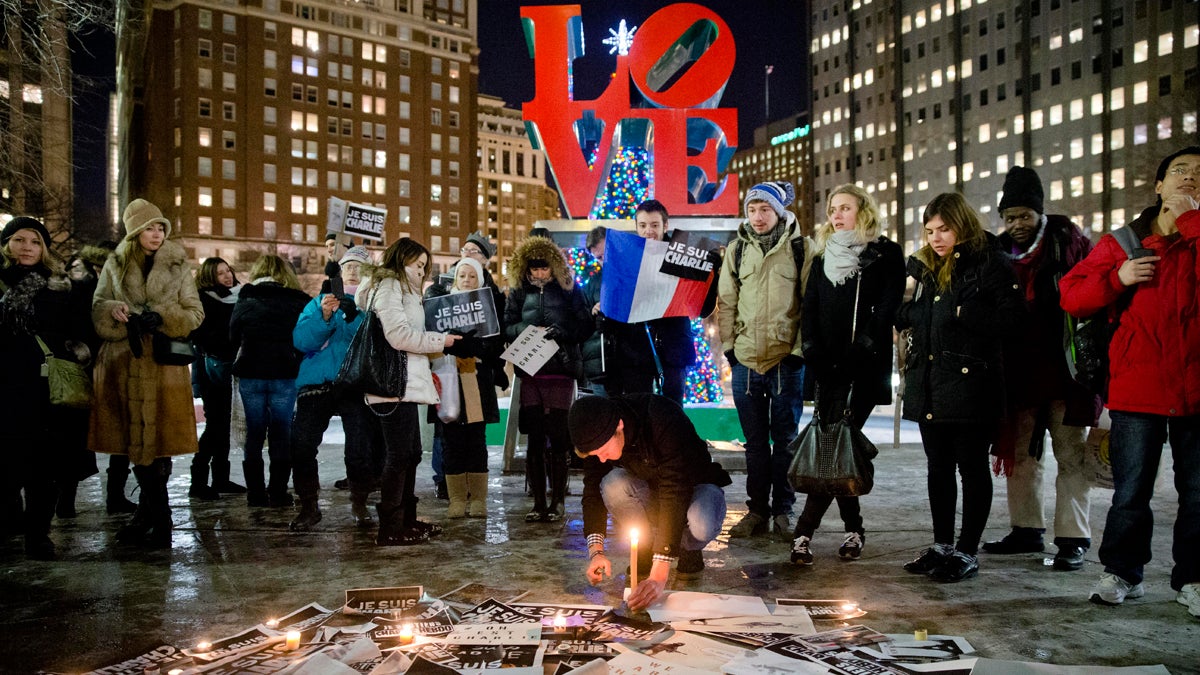Mainstream media outlets showed appropriate restraint in declining to reprint ‘Charlie Hebdo’ cartoons

People are shown gathering on Jan. 9, 2015, at JFK Plaza in Philadelphia, to pay tribute to victims of the terrorist attack against the French satirical weekly Charlie Hebdo. (AP Photo/Matt Rourke)
Free speech needs to be balanced against multicultural sensitivity. Right now, media outlets are weighing this balance as to whether to reprint the offending Charlie Hebdo cartoons.
The pen is mightier than the sword, but are there times when the pen should be kept in the pocket?
There has been justifiable outrage worldwide over the Islamist terrorist massacre of 12 journalists at Charlie Hebdo. There has also been appropriate emphasis on the need for free speech and satire. However, free speech needs to be balanced against multicultural sensitivity. Right now, media outlets are weighing this balance as to whether to reprint the offending Charlie Hebdo cartoons.
It could be deemed appropriate to reprint the cartoons to describe the controversy and explain the issue, but generally, media outlets should use restraint and self-censorship regarding content that is blatantly offensive to religious or racial groups. In this case, mainstream media outlets showed appropriate restraint in declining to reprint the controversial Charlie Hebdo cartoons.
After the controversial Danish cartoons depicting the prophet Mohammed in 2006, most U.S. newspapers and mainstream media outlets chose not to show the cartoons. Similarly, after last week’s incident in France, many U.S. papers and media outlets also declined to show the controversial images, including the New York Times, ABC News, NBC, Fox News, and the Associated Press. Some outlets like the New York Daily News and UK Telegraph ran the magazine’s controversial covers, but blurred the offending images.
As the New York Times explained, “Under Times standards, we do not normally publish images or other material deliberately intended to offend religious sensibilities. After careful consideration, Times editors decided that describing the cartoons in question would give readers sufficient information to understand today’s story.”
“We’ve taken the view that we don’t want to publish hate speech or spectacles that offend, provoke or intimidate, or anything that desecrates religious symbols or angers people along religious or ethnic lines,” said Santiago Lyon, a vice president of the Associated Press and its director of photography. “We don’t feel that’s useful.”
There were some exceptions, including the Washington Post op-ed page, Huffington Post, Slate, Vox, Daily Beast and BuzzFeed.
Every semester, I discuss the delicate balance between free speech and multicultural sensitivity with my journalism students. I give them a series of articles to read, starting with one defending the right to free speech and to express controversial and provocative ideas. But then I give them others that show that this right is not absolute.
Many media personalities have been penalized for exercising their right to free speech. Don Imus was fired for his “nappy-headed hos” comment about the Rutgers women’s basketball team; Dr. Laura Schlessinger resigned from her radio program after public outcry for her repeated use of the full “N-word,” allegedly as part of an academic discussion; an ESPN headline writer was fired for the headline “Chink in the Armor” after a loss by the New York Knicks and its Asian-American star Jeremy Lin; and Jimmy “the Greek” Snyder was taken off the air by CBS after his drunken explanation of why blacks were better athletes than whites.
There is a great tradition of editorial cartoons pushing the buttons, criticizing public officials, and mocking groups and institutions to make a point. It’s part of the Fourth Estate, the media, which keeps the government in check and exposes corruption. Free speech does include the right to offend.
The government cannot and should not stifle or censor controversial viewpoints. The right to publish controversial ideas should be absolute in theory, but in practice it’s not that simple. Generally, while the media should not hesitate to criticize religious and racial groups, they should consider self-censorship for outrageous, deliberately offensive content that simply serves to insult those groups.
There are times when media outlets could go too far. For example, as a hypothetical situation, what if during the Israel-Hamas war, an American newspaper published an American cartoon showing Palestinian victims with the tagline “Hitler was right”? In that hypothetical case, the cartoonist would likely be fired, editors would be forced to resign, and the newspaper would face justifiable outrage and boycotts. Yes, you have a right to express outrageous and controversial ideas, but sometimes it’s best to show restraint and have respect for certain segments of your readership. This is especially the case for mainstream media outlets that serve a wide range of diverse people.
Many free speech advocates consider self-censorship to be cowardly. In this case, they allege that media outlets that decline to show the controversial Charlie Hebdo cartoons are allowing the terrorists to win. Free speech is a valuable right, but it’s not absolute. Restraint should not be mandated, but sometimes it’s appropriate.
WHYY is your source for fact-based, in-depth journalism and information. As a nonprofit organization, we rely on financial support from readers like you. Please give today.

